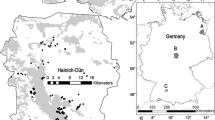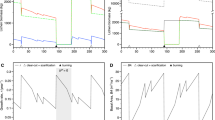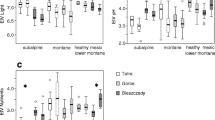Abstract
Roles of intensive reindeer grazing and several additional land use factors in the reduction in ground lichens (Cladonia spp.) in pastures grazed by the semi-domesticated reindeer have been argued in Finland. Our analysis showed that several factors and processes explain the standing biomass of lichens (during 2005–2008) and the recent changes in this biomass (after 1995–1996) on lichen pastures located in the 20 northernmost herding districts in Finland. The higher the long-term reindeer densities on the lichen pastures the lower was the lichen biomass. The lichen biomass was also strongly affected by the grazing system; the lowest biomass values of lichens were measured in all grazing areas that were used in the snow-free seasons. The lichen biomass in pine forests less than 80 years old and in all mountain type lichen pastures was lower than that in mature and old pine forests. The lichen biomass also decreased as the proportion of arboreal lichen pastures within a district decreased and the proportion of human infrastructure increased. The aerial drift of heavy metals from the Kola Peninsula appeared to reduce lichens in a small north-eastern part of the study area. Increases in summer precipitation and winter temperatures increased the amount of lichens, but increases in summer temperatures and winter precipitation had the opposite effect. Reindeer densities, grazing system, pasture type and the previous abiotic factors were also associated with the reduction in lichen biomass between the inventories. We conclude that several local, regional and even global factors and processes affect the state of reindeer pastures in large and complex grazing ecosystems. Therefore, more comprehensive research and management strategies for the entire reindeer herding environment are needed.


Similar content being viewed by others
References
Ahti T (1961) The open boreal woodland subzone and its relation to reindeer husbandry. Archivum Societatis Zoologicae Botanicae Fennicae ´Vanamo’ 16:91–93
Anttonen M, Kumpula J, Colpaert A (2011) Range selection by semi-domesticated reindeer (Rangifer tarandus tarandus) in relation to infrastructure and human activity in the boreal environment, northern Finland. Arctic 64(1):1–14
Berg A, Östlund L, Moen J, Olofsson J (2008) A century of logging and forestry in a reindeer herding area in northern Sweden. For Ecol Manage 256:1009–1020
Bråkenhielm S, Liu Q (1998) Long-term effects of clear-felling on vegetation dynamics and species diversity in a boreal pine forest. Biodivers Conserv 7:207–220
Burnham KP, Anderson DR (2002) Model selection and multimodel inference: a practical information-theoretic approach, 2nd ed. Springer, New York
Colpaert A, Kumpula J (2012) Detecting changes in the state of reindeer pastures in northernmost Finland, 1995–2005. Polar Record 48(Spec. Iss. 01):74–82
Cornelissen JHC, Callaghan TV, Alatalo JM, Michelsen A, Graglia E, Hartley AE, Hik DS, Hobbie SE, Press MC, Robinson CH, Henry GHR, Shaver GR, Phoenix GK, Gwynn Jones D, Johansson S, Chapin FS III, Molau U, Neill C, Lee JA, Melillo JM, Sveinbjörsson B, Aerts R (2001) Global change and arctic ecosystems: is lichen decline a function of increases in vascular plan biomass? J Ecol 89:984–994
Coxson DS, Marsh J (2001) Lichen chronosequences (postfire and postharvest) in lodgepole pine (Pinus contorta) forests of northern interior British Columbia. Can J Bot 79:1449–1464
Coxson D, Marsh J, Sulyma R (1998) Factors affecting terrestrial lichen abundance in woodland caribou habitat. Forest Renewal British Columbia, Report no. OP96029, Prince George, BC
Dahle B, Reimers E, Colman JE (2008) Reindeer (Rangifer tarandus) avoidance of a highway as revealed by lichen measurements. Eur J Wildl Res 54:27–35
den Herder M, Kytöviita M-M, Niemelä P (2003) Growth of reindeer lichens and effects of reindeer grazing on ground cover vegetation in a Scots pine forest and a subarctic heathland in Finnish Lapland. Ecography 26:3–12
Derome J, Aarrestad PA, Aspholm P, Bakkestuen V, Bjerke J, Erikstad K, Gytarsky M, Hartikainen M, Isaeva L, Karaban R, Korotkov V, Kuzmicheva V, Lindgren M, Lindroos AJ, Myking T, Poikolainen J, Rautio P, Røsberg I, Salemaa M, Tömmervik H, Vassilieva N (2007) Current state of terrestrial ecosystems in the joint Norwegian, Russian and Finnish border area. In: Stebel K, Christinsen G, Derome J, Grekelä I (eds) State of the environment in the Norwegian, Finnish and Russian border area. Lapland Regional Environment Centre, Finland; Office of the Finnmark County Covernor, Norway; Murmansk Department for Hydrometeorology and Environmental Monitoring, Russia
Dettki H, Esseen P-E (1998) Epiphytic macrolichens in managed and natural forest landscapes: a comparison at two spatial scales. Ecography 21:613–624
Dyer SJ, O’Neill JP, Wasel SM, Boutin S (2002) Quantifying barrier effects of roads and seismic lines on movements of female woodland caribou in northeastern Alberta. Can J Zool 80:839–845
Esseen P-A, Rehorn K-E (1998) Edge effects on an epiphytic lichen in fragmented forests. Conserv Biol 12(6):1307–1317
Esseen P-A, Renhorn K-E, Pettersson RB (1996) Epiphytic lichen biomass in managed and old-growth boreal forests: effect of branch quality. Ecol Appl 6(1):228–238
Finnish Environment Institute (2008) Suomen luontotyyppien uhanalaisuus—Osa 1 (In Finnish with English summary: the assessment of threatened habitat types in Finland—part 1). Suomen Ympäristö 8/2008. Suomen ympäristökeskus/Finnish Environment Institute. 264 p
Harmens H, Norris D, Participants of the moss survey (2008) Spatial and temporal trends in heavy metal accumulation in mosses in Europe (1990–2005). Centre for Ecology & Hydrology, Wales, UK, 52 p. http://icpvegetation.ceh.ac.uk/publications/documents/Finalmossreportwithmaps_110708_proofedits_180708_highquality.pdf
Harris A (1992) Post-logging regeneration of reindeer lichens (Cladina spp.) as related to woodland caribou winter habitat. Northwest Region Science and Technology, Technical report 69. 33 p
Helle T (1981) Observations of home ranges and grouping patterns of freeranging semi-domestic reindeer (Rangifer tarandus tarandus L.) in Kuusamo, northern Finland. Kuusamo. Research Institute of Northern Finland A2:33–53
Helle T, Jaakkola LM (2008) Transition in herd management of semi-domesticated reindeer in northern Finland. Ann Zool Fenn 45:81–101
Helle T, Kojola I (1992) Harmaaporonjäkälän kasvunvaihtelu Itä-Fennoskandiassa. In Finnish with English abstract: The variation in the growth rate of Cladonia rangiferina in eastern Fennoscandia. In: Kauhanen H, Varmola M (eds) Itä-Lapin metsävaurioprojektin väliraportti (The Lapland forest damage project interim report). Metsäntutkimuslaitoksen tiedonantoja 413:106–114
Helle T, Saastamoinen L (1979) The winter use of food resources of semi-domestic reindeer in northern Finland. Forestalis Fenniae 95(1):1–26
Helle T, Särkelä M (1993) The effect of outdoor recreation on range use by semi-domesticated reindeer. Scand J For Res 8:123–133
Helle T, Kilpelä S-S, Aikio P (1990) Lichen densities and production in Finnish reindeer management. Rangifer, special issue no. 3:115–121
Henry GHR, Gunn A (1991) Recovery of tundra vegetation after overgrazing by caribou in Arctic Canada. Arctic 44(1):38–41
Jandt R, Joly K, Meyers CR, Racine C (2008) Slow recovery of lichen on burned caribou winter range in Alaska tundra: potential influences of climate warming and other disturbance factors. Arct Antarct Alp Res 40(1):89–95
Joly K, Jandt R, Meyers CR, Cole MJ (2007) Changes in vegetative cover on western Arctic herd winter range from 1981 to 2005: potential effects of grazing and climate change. Rangifer, Special Issue 17:199–207
Joly K, Jandt RR, Klein DR (2009) Decrease of lichens in arctic ecosystems: the role of wildfire, caribou, reindeer competition and climate in north-western Alaska. Polar Res 28:433–442
Jonsson Čabrajić AA (2009) Modelling lichen performance in relation to climate—scaling from thalli to landscapes. Doctoral thesis, Department of Ecology and Environmental Sciences, Umeå University. 38 p, and five separate articles
Jonsson Čabrajić AA, Moen J, Palmquist K (2010) Predicting growth of mat-forming lichens on a landscape scale—comparing models with different complexities. Ecography 33:949–960
Kappen L, Lange OL (1970) The cold resistance of phycobionts from macrolichens of various habitats. Lichenologist 4:289–293
Kershaw KA (1978) The role of lichens in boreal tundra transition areas. Bryologist 81(2):294–306
Kivinen S, Moen J, Berg A, Eriksson Å (2010) Effects of modern forest management on winter grazing resources for reindeer in Sweden. Ambio 39:269–278
Kivinen S, Berg A, Moen J, Ostlund L, Olofsson J (2012) Forest fragmentation and landscape transformation in a reindeer husbandry area in Sweden. Environ Manage 49(2):295–304
Klein DR (1968) The introduction, increase, and crash of reindeer on St. Matthew island. Wildl Manage 32(2):350–367
Klein DR (1982) Fire, lichens, and caribou. J Range Manage 35(3):390–395
Klein DR, Shulski M (2009) Lichen recovery following heavy grazing by reindeer delayed by climate warming. Ambio 38(1):11–16
Kojola I, Aikio P, Helle T (1993) Luontaisten ravintovarojen vaikutus porotalouteen Pohjois-Lapissa (In Finnish). Research report 116, Research Institute of Northern Finland, University of Oulu
Kojola I, Helle T, Niskanen M, Aikio P (1995) Effects of lichen biomass on winter diet, body mass and reproduction of semi-domesticated reindeer Rangifer t. tarandus in Finland. Wildl Biol 1(1):33–38
Kumpula J, Colpaert A, Kumpula T, Nieminen M (1997) Suomen poronhoitoalueen talvilaidunvarat (In Finnish: The reindeer winter pasture resources in Finland. Kalaja Riistaraportteja nro 93, The Finnish Game and Fisheries Research Institute, Kaamanen, 42 p
Kumpula J, Colpaert A, Nieminen M (1998) Reproduction and productivity of semidomesticated reindeer in northern Finland. Can J Zool 76:269–277
Kumpula J, Colpaert A, Nieminen M (2000) Condition, potential recovery rate and productivity of lichen (Cladina spp.) ranges in the Finnish reindeer management area. Arctic 53(2):152–160
Kumpula J, Colpaert A, Tanskanen A, Anttonen M, Törmänen H, Siitari J (2006) Porolaidunten inventoinnin kehittäminen—Keski-Lapin paliskuntien laiduninventointi vuosina 2005–2006 (in Finnish with English abstarct: Developing reindeer pasture inventory—Pasture inventory in the reindeer herding districts in Middle-Lapland during 2005–2006). Kala-ja riistaraportteja, nro 397, Reports of Finnish Game and Fisheries Research Institute, Helsinki, 67 p
Kumpula J, Colpaert A, Anttonen M (2007) Does forest harvesting and linear infrastructure change the usability value of pastureland for semi-domesticated reindeer (Rangifer tarandus tarandus)? Ann Zool Fennici 44:161–178
Kumpula J, Colpaert A, Tanskanen A (2008) Porojen laidunten valinta muuttuneessa metsä- ja maisemarakenteessa Keski-Lapissa. In Finnish with English Summary: Pasture selection by semi-domesticated reindeer in the changed forest and landscape structure of central Lapland. Suomen Riista 54:69–82
Kumpula J, Tanskanen A, Colpaert A, Anttonen M, Törmänen H, Siitari J, Siitari S (2009) Poronhoitoalueen pohjoisosan talvilaitumet vuosina 2005–2008—laidunten tilan muutokset 1990-luvun puolivälin jälkeen. In Finnish with English abstract: winter pastures in the northern part of the reindeer management area in Finland during 2005–2008—changes in the state of pastures after the mid-1990s. Riistaja kalatalous—Tutkimuksia 3/2009, 48 p
Kumpula J, Stark S, Holand Ø (2011) Seasonal grazing effects by semi-domesticated reindeer on subarctic mountain birch forests. Polar Biol 34:441–453
Lecowicz MJ (1982) The effects of simulated acid precipitation on photosynthesis in the caribou lichen. Water Air Soil Pollut 18:421–430
Manseau M, Huot J, Crête M (1996) Effects of summer grazing by caribou on composition and productivity of vegetation: community and landscape level. J Ecol 84:503–513
Mattila E (1981) Survey of reindeer winter ranges as a part of the Finnish National Forest Inventory in 1976–1978. Communicationes Instituti Forestalis Fenniae 99(6):74
Mattila E, Mikkola K (2009) Poronhoitoalueen eteläja keskiosan talvilaitumet (in Finnish). Metlan Työraportteja 115:57
METLA (2011) 2 Metsien monimuotoisuus ja terveys (2 Forest biodiversity and health). Metsätilastollinen vuosikirja 2011. Finnish Statistical Yearbook of Forestry 2011. Finnish Forest Research Institute, 116 p. http://www.metla.fi/metinfo/tilasto/julkaisut/vsk/2011/vsk11_02.pdf, see page 99
METLA (2012) MetINFO—Metsien terveys. Raskasmetallit ja typpilaskeuma Suomessa—kartoitus sammalten pitoisuuksien perusteella 1985–2010. http://www.metla.fi/metinfo/metsienterveys/raskasmetalli/tulokset.htm, see additional link to Nikkeli (Ni) and Kupari (Cu) maps
Moen J, Danell Ö, Holt R (2007) Non-destructive estimation of lichen biomass. Rangifer 27(1):41–46
Myking T, Aarrestad PA, Derome J, Bakkestuen V, Bjerke JW, Gytarksky M, Isaeva L, Karban R, Korotkov V, Lingren M, Lindroos A-J, Røsberg I, Salenmaa M, Tømmervik H, Vassilieva N (2009) Effects of air pollution from a nickel-copper industrial complex on boreal forest vegetation in the joint Russian-Norwegian-Finnish border area. Boreal Environ Res 14:279–296
Nellemann C, Vistnes I, Jordhøy P, Strand O (2001) Winter distribution of wild reindeer in relation to power lines, roads and resorts. Biol Conserv 101:351–360
Nellemann C, Vistnes I, Jordhøy P, Strand O, Newton A (2003) Progressive impact of piecemeal infrastructure development on wild reindeer. Biol Conserv 113:307–317
Nieminen M (2008) Porolaidunten kunto ja poromäärät sekä poronomistajien että ruokakuntien poromäärien muutokset. In: Rantamäki-Lahtinen (ed) Porotalouden taloudelliset menestystekijät. MTT:n selvityksiä 156:46–92
Olsson BA, Kellner O (2006) Long-term effects of nitrogen fertilization on ground vegetation in coniferous forests. For Ecol Manage 237:458–470
Ouellet J-P, Heard DC, Boutin S (1993) Range impacts following the introduction of caribou on Southampton Island, Northwest Territories, Canada. Arctic Alpine Res 25(2):136–141
Ouellet J-P, Heard DC, Mulders R (1996) Population ecology of caribou populations without predators: Southampton and Coats Island herds. Rangifer, special issue no. 9:17–25
Poikolainen J (1997) Sulphur and heavy metal concentrations in Scots pine bark in northern Finland and the Kola peninsula. Water Air Soil Pollut 93:395–408
Reinikainen A, Mäkipää R, Vanha-Majamaa I, Hotanen J-P (2000) Kasvit muuttuvassa metsäluonnossa. Kustannusosakeyhtiö Tammi, Helsinki. 384 s
Routier S, Bergsten U (2006) Influence of soil scarification on reindeer foraging and damage to planted Pinus sylvestris seedlings. Scand J For Res 21:209–220
Rowe JS (1984) Lichen woodlands in northern Canada. In: Olson R, Geddes F, Hastings R (eds) Northern ecology and resource management, memorial essays honouring Don Gill. The University of Alberta Press, Canada, pp 225–237
Russell DE, Martell AM (1984) Winter range ecology of caribou (Rangifer tarandus). In: Olson R, Hastings R, Geddes F (eds) Northern ecology and resource management, memorial essays honouring Don Gill. The University of Alberta Press, Canada, pp 117–144
Salemaa M, Derome J, Helmisaari H-S, Nieminen T, Vanha-Majamaa I (2004) Element accumulation in boreal bryophytes, lichens and vascular plants exposed to heavy metal and sulfur deposition in Finland. Sci Total Environ 324:141–160
SAS (2011) SAS, OnlineDoc, version 9.3. SAS Institute Inc., Cary, NC, USA
Schindler DW, Walker D, Davis T, Westwood R (2007) Determining effects of an all weather logging road on winter woodland caribou habitat use in south-eastern Manitoba. Rangifer, special issue no. 17:209–217
Scotter GW (1967) The winter diet of barren-ground caribou in northern Canada. Field Nat 81:33–39
Seip DR, Johnson CJ, Watts GS (2007) Displacement of mountain caribou from winter habitat by snowmobiles. J Wildl Manage 71(5):1539–1544
Skogland T (1985) The effects of density-dependent resource limitations on the demography of wild reindeer. J Anim Ecol 54:359–374
Sulyma R, Coxson DS (2001) Microsite displacement of terrestrial lichens by feather moss mats in late seral pine-lichen woodlands of north-central British Columbia. Bryologist 104(4):505–516
Tanskanen A (2007) Satelliittikuvatulkintamenetelmät porolaidunkartoituksessa: puoliohjaamaton luokitus. Pro gradu thesis, University of Joensuu, Geography, 63 p
Tarhanen S, Poikolainen J, Holopainen T, Oksanen J (2000) Severe photobiont injuries of lichens are strongly associated with air pollution. New Phytol 147:579–590
Tietäväinen H, Saku S, Venäläinen A (2011) Mitä havainnot kertovat Suomen tähänastisesta ilmastosta? (in Finnish). Presentation in ACCLIM symposium, 8.3.2011, Helsinki. See: http://ilmatieteenlaitos.fi/c/document_library/get_file?uuid=c2d14332-a9a7-484c-923e-85cb866bdeb9&groupId=30106
Tømmervik H, Johansen B, Tombre I, Thannheiser D, Høgda KA, Gaare E, Wielgolaski FE (2004) Vegetation changes in the Nordic mountain birch forest: the influence of grazing and climate change. Arct Antarct Alp Res 36(3):323–332
Tømmervik H, Johansen B, Riseth JÅ, Karlsen SR, Solberg B, Høgda KA (2009) Above ground biomass changes in the mountain birch forests and mountain heaths of Finnmarksvidda, northern Norway, in the period 1957–2006. For Ecol Manage 257:244–257
Tømmervik H, Bjerke JW, Gaare E, Johansen B, Thannheiser D (2012) Rapid recovery of recently overexploited winter grazing pastures for reindeer in northern Norway. Funct Ecol 5:3–15
UNEP (2001) GLOBIO—Global methodology for mapping human impacts on the biosphere. In: Nellemann C, Kullerud L, Vistnes I, Forbes BC, Husby E, Kofinas GP, Kaltenhorn BP et al (eds) Nairobi, Kenya, UNEP/DEWA/TR.01.3. www.globio.info/downloads/218/globioreportlowres.pdf
Väre H, Ohtonen R, Oksanen J (1995) Effects of reindeer grazing on vegetation in dry Pinus sylvestris forests. J Veg Sci 6:523–530
Väre H, Ohtonen R, Mikkola K (1996) The effect and extent of heavy grazing by reindeer in oligotrophic pine heaths in northeastern Fennoscandia. Ecography 19:245–253
Vistnes I, Nellemann C (2001) Avoidance of cabins, roads, and power lines by reindeer during calving. J Wildl Manage 65:915–925
Vistnes I, Nellemann C, Jordhøy P, Strand O (2001) Wild reindeer: impact of progressive infrastructure development on distribution and range use. Polar Biol 24:531–537
Vors LS, Boyce MS (2009) Global declines of caribou and reindeer. Glob Change Biol 15(11):2626–2633
Webb ET (1996) Survival, persistence, and regeneration of the reindeer lichens, Cladina stellaris, C. rabgiferina, and C. mitis following clearcut logging and forest fire in northwestern Ontario. Rangifer, special issue no. 10:41–47
Weir JN, Mahoney SP, McLaren B, Ferguson M (2007) Effects of mine development on woodland caribou Rangifer tarandus distribution. Wildl Biol 13(1):66–74
Weladji R, Holand Ø (2006) Influences of large-scale climatic variability on reindeer population dynamics: implications for reindeer husbandry in Norway. Clim Res 32:119–127
Acknowledgments
The reindeer pasture inventories the data of which provide the basis of this study were funded by the Ministry of Forestry and Agriculture in Finland. We thank all of the people who helped conduct the pasture inventories and the data handling. Special thanks go to Ari Tanskanen of the University of Eastern Finland for developing the image classification system and to Heikki Törmänen, Jukka Siitari and Sari Siitari of the Finnish Game and Fisheries Research Institute for helping to collect and handle the pasture inventory data. We also thank Mari Pukkinen of the Finnish Game and Fisheries Research Institute for helping to handle the weather observations grid data.
Author information
Authors and Affiliations
Corresponding author
Appendices
Appendix 1
See Table 7.
Appendix 2
See Table 8.
Appendix 3
See Table 9.
Rights and permissions
About this article
Cite this article
Kumpula, J., Kurkilahti, M., Helle, T. et al. Both reindeer management and several other land use factors explain the reduction in ground lichens (Cladonia spp.) in pastures grazed by semi-domesticated reindeer in Finland. Reg Environ Change 14, 541–559 (2014). https://doi.org/10.1007/s10113-013-0508-5
Received:
Accepted:
Published:
Issue Date:
DOI: https://doi.org/10.1007/s10113-013-0508-5




